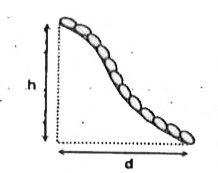A bicyclist of mass 80 kg (including the bicycle) can coast down a 3.4∘ hill at a steady speed of 6 kph Pumping hard, the cyclist can descend the hill at a speed of 30 kph Using the same power, at what speed cant he cyslist climb the same hill ? Assume the force of friction is directly proportional to the speed v.
The correct Answer is:B, D
Step by step video, text & image solution for A bicyclist of mass 80 kg (including the bicycle) can coast down a 3.4^(@) hill at a steady speed of 6 kph Pumping hard, the cyclist can descend the hill at a speed of 30 kph Using the same power, at what speed cant he cyslist climb the same hill ? Assume the force of friction is directly proportional to the speed v. by Physics experts to help you in doubts & scoring excellent marks in Class 11 exams.
Updated on:21/07/2023Topper's Solved these Questions
- WORK, ENERGY AND POWERBook:PHYSICS GALAXY - ASHISH ARORAChapter:WORK, ENERGY AND POWERExercise:unsolved
Explore 1 Video
- WORK, ENERGY AND POWERBook:PHYSICS GALAXY - ASHISH ARORAChapter:WORK, ENERGY AND POWERExercise:MCQ
Explore 158 Videos
- RIGID BODIES AND ROTATIONAL MOTIONBook:PHYSICS GALAXY - ASHISH ARORAChapter:RIGID BODIES AND ROTATIONAL MOTIONExercise:Unsolved Numerical
Explore 63 Videos
Similar Questions
A trolley car starts from rest at the top of a hill as shown in figure -3.9 and moves down the curved track. Determine its speed as it reaches the bottom. Assume that the work done by frictional forces is negligible.
View SolutionA truck can move up a road which has a gradient of 1 m rise every 50 m with a speed of 24 kmph ? How fast will the same truck move down the hill with the same horse power ? The air resistance to the motion of the truck is 1/25 of its weight.
View Solution
Knowledge Check
A person, who can walk down a hill a the speed of 412 km/hr and up the hill at the rate of 3 km/hr, ascends and comes down to his starting point in 5 hours. How far did he ascent ?
A13.5 kmB3 kmC15 kmD9 kmA man of mass 65 kg is holding a bucket of mass 15 kg. He walks 50 m on a level road at a constant speed of 3 m/s and then climbs up a hill of height 20 m. What is the work done by the man? Takeg=10ms2.
A2.05kJB3.5kJC12kJD16kJA boy climbs up a hill, which rises 1 in every 25, on his bicycle. The mass of the boy and his bicycle is 120 kg. What is the power applied by the body if he is cycling at the rate of 6 km/h hour? (Assume the friction is absent and g=10m/s2)
A80 wattB70 wattC100 wattD120 watt
A truck tows a trailor of mass 1200kg at a speed of 10m/s on a level road The tension in the coupling is 1000N
(i) What is power expended on the trailor ?
(ii) Find tension in the coupling when the truck accends a road having an inclination of 1 in 6 Assume that the frictional resistance of the incline is same as that on the level road .
View SolutionA uniform chain of mass per unit length λ is sliding down the hill with constant speed u. Dimension of the hill are h and d as shown. Find the momentum of the chain at the instant shown. (given λ=1kg/m,d=3m,h=4m,andu=1m/s)

View SolutionA 80 kg person expends 400 W when walking on a horizontal tracker belt at a speed of 7.2 kph. When the tracker belt is inclined without changing the speed, the person's expended power increases to 600 W. Estimate the angle of incline of the tracker belt by assuming that all of the increased output power goes into overcoming the force of gravity. Assume constant friction by tracker belt in both horizontal and inclined position Takeg=10m/s2
View SolutionAn elevator has mass of 600 kg, not including passengers The elevator is designed to ascend at constant speed a vertical distance of 20 m in 15 sec. It is driven by a motor that can provide up to 30 hp to the elevator, what is the maximum number of passengers that can ride in the elevator ? Assume that an average passenger has a mass of 65 kg
View SolutionA 63-kg skier goes up a snow-convered hill that makes an angle of 25∘ with the horizontal . The initial speed of the skier is 6.6 m/s. After coasting a distance of 1.9 m up the slope, the speed of the skier is 4.4 m/s. Find the work done by the kinetic frictional force that acts on the skis .
View Solution